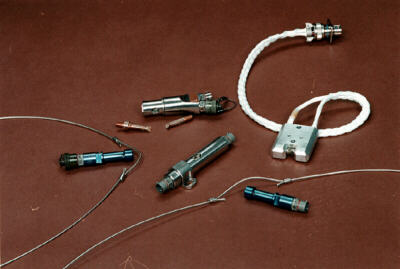
In space engineering, satellites and launchers use many devices for igniting, moving, separating or activating various elements. These devices are generally triggered by electro-pyrotechnic components in which at least one phase involves the rapid decomposition of pyrotechic substances at high pressure and temperature.
The basic problem posed by these components for observation satellites is leakage of
combustion gases which may contaminate optics. The manufacturers' main aim is to design
devices that are leak-proof before, during and after operation.
Their design must also comply with mass, volume, reliability and safety specifications.
On SPOT 4 and the onboard experimental packages such as PASTEL, pyromechanisms are used to separate and release stowed appendages. This is done by means of cable cutters, bolt cutters or shears which section stainless steel cables or steel rods and even cupro beryllium.
Since the design of the cables or rods takes prestressing into account, the required pyro-mechanism is chosen according to its nominal cutting capacity and required design margins. This type of pyrotechnic actuator can cut materials from 1.5 to 10 mm in diameter.
The SPOT programme's reliability specifications require that components have built-in electrical and pyrotechnical redundancy (two initiators -e.g. type 7 CC 60DPWH) and even in some cases a back-up cutting mechanism (types 7 CCD 45DPWH and 7 CCD15W). In the case where the component only has one initiator (type GPY 1600) the function is guaranteed by using two.
These pyrotechnical components are associated with mechanisms which normally move during operation and which have to be protected against launch vibration.

The shear principle uses a knife powered by a piston. This is done by igniting an explosive charge. The pyrotechnical reaction is triggered by an initiator ignited by an electrical pulse. The devices are sealed by a metal-plastic joint or by two, silicon o-rings mounted on the piston.
Click on the image for AVI format animation.
![]()
page updated on the 00-06-06